Posters Empowering Community:
A Historical Snapshot of SA Poster Artmaking
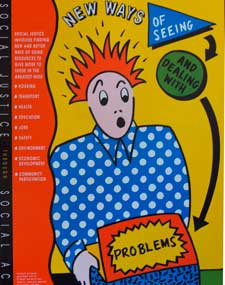 |
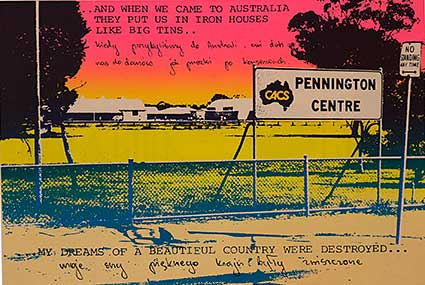 |
Kerry Packer Civic Gallery Exhibition
Exhibition dates: Monday 15 May - Wednesday 31 May
Gallery open Monday - Friday 9am - 5pm (Thursdays until 7pm)
Hawke Building level 3, UniSA City West campus, 55 North Terrace, Adelaide
This timely exhibition of historical poster art will represent many social issues relevant from the early 1970s through to the 1990s in South Australia for the 2017 History Festival.
The exhibition will feature significant posters with social and political commentary produced in this era and represent a historical snapshot of Community Media Association (Co-Media) and Community Arts Network (CAN) and other organisations behind this important movement of politically motivated poster making. In an era before digital social media, the poster was used as a political tool to actively communicate information and debate to a mass audience.
The screen printing genre was a legitimate method of producing art highlighting the community’s social conscience and the posters are now a historical record of those times and highly sought after collectable items. The collection of nearly 200 posters produced or printed by Co-Media, CAN and other organisations since the early 1970s, were bequeathed to The Graham F Smith Peace Foundation on the closure of CAN in 2006. As a not-for-profit, non-funded organisation, The Peace Foundation has been supporting artists for over 25 years to represent social, Indigenous or environmental issues through art. The sale of these posters will assist the Peace Foundation to continue this valuable support.
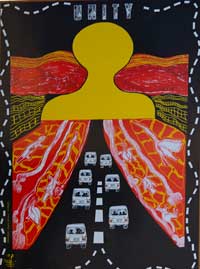 |
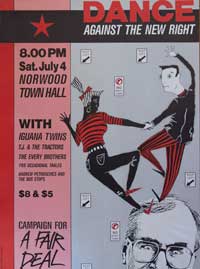 |
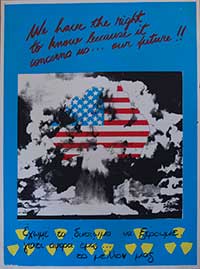 |
More information about the Graham F Smith Peace Foundation
|
|
|
Presented by The Bob Hawke Prime Ministerial Centre and the Graham F Smith Peace Foundation
This is a South Australia History Festival event
This exhibition complements
Posters Empowering Community
Forum: political & social impact of 1970s-1990s poster-art
Thursday 18 May, 5.30-8.00pm, Bradley Forum.
This forum allows the audience to transport themselves to times before digital social media when Community-Media and Community Arts Network produced posters as political and social tools during the 1970s–1990s. Did these posters reflect community social consciousness or inspire change and social action? The audience can participate in discussions with leading authorities of those progressive times.
Lisa Philip Harbutt – Facilitator
Lisa was Director of Community Arts Network South Australia - 2003 –2013. She is Artist/Researcher completing a PhD at the University of Adelaide Business School. Lisa is passionate about using art-making as a tool for social change.
Dr Kathie Muir
Kathie Muir is a Senior Lecturer in Gender, Work and Social Inquiry at University of Adelaide. Her teaching and research spans the areas of gender, labour, media and politics and has published articles on gendered representation in the media of many aspects of society in both Australia and internationally.
Prof Andrew Hill AM
Andrew is an Adjunct Associate Professor, School of Art, Architecture and Design at UniSA. He is an Adelaide-born painter and printmaker whose exhibitions have been identified as benchmarks for both community cultural development and for the development of multicultural arts within Australia.
John Hopkinson
John was involved from the early days of the Community Media Association, firstly as a participant in 1997, then as Director from 1979 – 1988. John was involved with many of the projects and posters during this time as an organiser and as an artist.
Peter Drew
Peter is Adelaide born and holds a Masters Degree from the Glasgow School of Art. His artworks have been exhibited at the Art Gallery of South Australia and the National Gallery of Australia, though his most prominent work is installed on city streets. Peter states that: ‘I like to exhibit my art on the street because public space is a great equaliser, and it’s also an ancient forum. When you address the public through the street you’re entering into a tradition that emphasises our fundamental freedom of expression, over the value of property...I enjoy examining our collective identities and my aim is always to emphasize the connections that bind up, rather than the fractures that divide us.’
Image credits:
Top right: Pennington Centre, My Dreams of a Beautiful Country were destroyed, 1984-85; ‘Mosaic’ Screenprinting Project; Produced by Co-Media with Findon High School. Top left: New Ways of Seeing, undated; Jayne Amble; Produced by Community Arts Network. Bottom left: Unity, 1988; Kurwingie (Kerry Giles); Produced by Co-Media. Bottom middle: Dance Against the New Right, undated; Deborah Kelly; Produced by Co-Media. Bottom right: We Have the Right to Know, 1984-1985, undated, Mosaic Screenprinting Project, Produced by Co-Media with Findon High School
While the views presented by speakers within the Hawke Centre public program are their own and are not necessarily those of either the University of South Australia or The Hawke Centre, they are presented in the interest of open debate and discussion in the community and reflect our themes of: strengthening our democracy - valuing our diversity - and building our future.
The copying and reproduction of any transcripts within the Hawke Centre public program is strictly forbidden without prior arrangements.
While the views presented by speakers within The Bob Hawke Prime Ministerial Centre public program are their own and are not necessarily those of either the University of South Australia, or The Bob Hawke Prime Ministerial Centre, they are presented in the interest of open debate and discussion in the community and reflect our themes of: Strengthening our Democracy - Valuing our Diversity - Building our Future. The Hawke Centre reserves the right to change their program at any time without notice.




